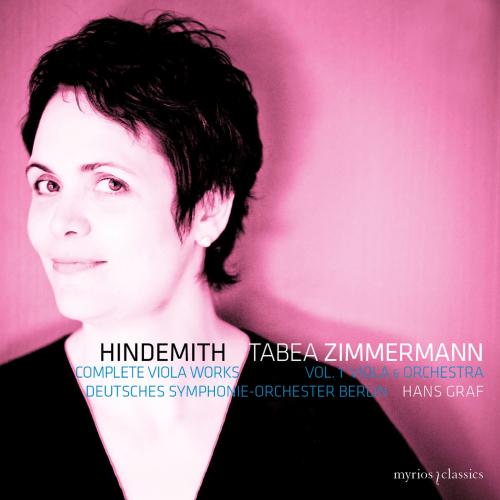
Complete Works for Viola Vol. 1 "Viola and Orchestra" Tabea Zimmermann, Deutsches Symphonie-Orchester Berlin & Hans Graf
Album info
Album-Release:
2013
HRA-Release:
15.08.2023
Label: Myrios Classics
Genre: Classical
Subgenre: Concertos
Artist: Tabea Zimmermann, Deutsches Symphonie-Orchester Berlin & Hans Graf
Composer: Paul Hindemith (1895-1963)
Album including Album cover Booklet (PDF)
I`m sorry!
Dear HIGHRESAUDIO Visitor,
due to territorial constraints and also different releases dates in each country you currently can`t purchase this album. We are updating our release dates twice a week. So, please feel free to check from time-to-time, if the album is available for your country.
We suggest, that you bookmark the album and use our Short List function.
Thank you for your understanding and patience.
Yours sincerely, HIGHRESAUDIO
- Paul Hindemith (1895 - 1963): Concerto After Old Folk Songs for Viola & Small Orchestra "Der Schwanendreher":
- 1 Hindemith: Concerto After Old Folk Songs for Viola & Small Orchestra "Der Schwanendreher": I. "Zwischen Berg und tiefem Tal" 08:17
- 2 Hindemith: Concerto After Old Folk Songs for Viola & Small Orchestra "Der Schwanendreher": II. "Nun laube, Lindlein laube" 09:33
- 3 Hindemith: Concerto After Old Folk Songs for Viola & Small Orchestra "Der Schwanendreher": III. Variationen "Seid Ihr nicht der Schwanendreher" 08:49
- Trauermusik for Viola and String Orchestra:
- 4 Hindemith: Trauermusik for Viola and String Orchestra 07:33
- Kammermusik No. 5 for Solo Viola & Large Chamber Orchestra, Op. 36 No. 4:
- 5 Hindemith: Kammermusik No. 5 for Solo Viola & Large Chamber Orchestra, Op. 36 No. 4: I. Schnelle Halbe 04:08
- 6 Hindemith: Kammermusik No. 5 for Solo Viola & Large Chamber Orchestra, Op. 36 No. 4: II. Langsam 08:17
- 7 Hindemith: Kammermusik No. 5 for Solo Viola & Large Chamber Orchestra, Op. 36 No. 4: III. Mässig schnell 03:34
- 8 Hindemith: Kammermusik No. 5 for Solo Viola & Large Chamber Orchestra, Op. 36 No. 4: IV. Variante eines Militärmarsches 03:14
- Konzertmusik for Solo Viola & Large Chamber Orchestra, Op. 48a:
- 9 Hindemith: Konzertmusik for Solo Viola & Large Chamber Orchestra, Op. 48a: I. Lebhaft. Bewegte Halbe 04:27
- 10 Hindemith: Konzertmusik for Solo Viola & Large Chamber Orchestra, Op. 48a: II. Ruhig gehend 07:07
- 11 Hindemith: Konzertmusik for Solo Viola & Large Chamber Orchestra, Op. 48a: III. Lebhaft 02:37
- 12 Hindemith: Konzertmusik for Solo Viola & Large Chamber Orchestra, Op. 48a: IV. Langsam. Schreitende Achtel 03:23
- 13 Hindemith: Konzertmusik for Solo Viola & Large Chamber Orchestra, Op. 48a: V. Leicht bewegt 03:57
- Konzertmusik, Op. 48a:
- 14 Hindemith: Konzertmusik, Op. 48a: VI. Lebhaft und munter 04:33
Info for Complete Works for Viola Vol. 1 "Viola and Orchestra"
The Emancipation of the Viola: Tabea Zimmermann commemorates the 50th anniversary of the composer's death with her recording of the complete works for viola by Paul Hindemith. Hindemith is considered one of the most important composers for the viola and also played the instrument successfully himself, being the soloist in the premieres of the viola concertos by Darius Milhaud and William Walton. One of his best-known works, the viola concerto "Der Schwanendreher," was written in 1935, when he was already facing massive hostility from the National Socialists. The planned performance of the work in England in 1936 was cancelled as a result of the death of King George V, whereupon Hindemith quickly composed the intimate and moving "Music of Mourning" and premiered it himself.
Hindemith composed his works for viola and orchestra for his own needs, in order to expand the repertoire, which was less extensive than that of other solo instruments. His first viola concerto, Kammermusik No. 5 Op. 36 No. 4, was written in 1927 and adopts baroque movement characteristics, especially in the first movement, including toccata-like motor rhythms and melodic formations orientated on linear connections. The almost constant presence of the solo instrument requires maximum endurance on the part of the soloist, without whom the piece would hardly make its effect. To anticipate: Tabea Zimmermann's interpretational approach is new and the result is simply brilliant. She does not just fiddle around motorically and monotonously, or make a show of virtuosity, but shapes the nuances with great imagination and the utmost technical sovereignty.
Hindemith composed his concerto Der Schwanendreher in 1935 at a time when he was the victim of National Socialist denunciations and defamations by the Nazi press. The composer/soloist, presenting himself as a minstrel without a homeland, unfolds his tunes based on old German folksongs before an imaginary, festive community. In contrast to the works of his earlier sturm-und-drang years, Hindemith develops the sound in a subtle fashion here, conjuring forth soft, almost intimate timbres. It is precisely this inward-looking quality that Tabea Zimmermann brings out in congenial interaction with the orchestra in a way unheard before, by tracing the melodic contours with the sonorous and richly nuanced sound of the viola. Zimmermann presents the folksongs extensively used by Hindemith in a large arc, so that the contents associated by the song texts are conveyed organically, as a unity. This is indeed a minstrel who reflects upon his fate!
The Konzertmusik Op. 48 (1930) in its early version is a premiere recording. Especially in the fourth movement, discarded in the later version, the artists conjure up an atmosphere of chamber music marked by the dialogue of individual instruments with the viola. In these passages, the interpreters succeed in communicating the inner quality of this music. It is wonderfully reserved and yet played in a highly expressive manner! Tabea Zimmermann and the DSO take on the faster movements with a playfully concertante approach, bringing out the contrasts between lyrically reflective and virtuosic, playful sections.
Equally intensive is the interpretation of the Funeral Music in memory of King George V by Tabea Zimmermann and Hans Graf. In this work, Hindemith has recourse to the tone of the Burial from the Mathis Symphony, allowing the solo instrument to play chamber music with the solo strings and also to appear as soloist contrasting with the full ensemble. The free solo arabesques of the chorale melody Vor deinen Thron tret' ich hiermit make a placid, transfiguring impression.
Through her chamber-music approach to performing these works, Tabea Zimmermann succeeds in subtly exploring the dimensions of depth in these compositions of Hindemith. (Heinz-Jürgen Winkler)
"Tabea Zimmermann s first volume of a complete survey immediately takes its place among the very best, not least for the warmer, woodier tone that she produces and puts to such musically penetrating use." (John Allison, BBC Music Magazine)
"There is a heartfelt passion and robust edge to Zimmermann s playing which blows away the cobwebs and brings these works very much to life. Making a highly sympathetic partner the excellent DSO Berlin is warmly expressive and well detailed. Austrian conductor Hans Graf holds everything together with confidence. I am delighted by this wonderfully clear SACD with its vivid and warm sound which I played on my standard CD player. The slightly forward balance of the solo viola is very much to my taste. This is certainly a Record of the Month. I m so enthusiastic about this release that will definitely be one of my Records of the Year." (Michael Cookson, MusicWeb International)
Tabea Zimmermann, violin
Deutsches Symphonie-Orchester Berlin
Hans Graf, conductor
Tabea Zimmermann
is one of the most renowned and celebrated performers of our time. Audiences and fellow musicians value her profound musical insight and the naturalness of her playing. The violist has received numerous awards for her artistic accomplishments, most recently the prestigious Ernst von Siemens Music Prize in 2020.
As a soloist, she regularly works with the world’s leading orchestras. In recent years, she has held residencies in Weimar and Luxembourg, and with the Royal Concertgebouw Orchestra, the Berlin Philharmonic Orchestra and Hamburg’s Ensemble Resonanz, with which she continues to collaborate closely.
Zimmermann has awakened the interest of many contemporary composers in the viola, and has premiered several new works. Her discography encompasses more than 50 award-winning CDs, among them recordings of Paul Hindemith’s complete works for viola, and pieces by Johann Sebastian Bach and Max Reger. One of the highlights of her intensive engagement with Ludwig van Beethoven involved recording using the composer’s own viola.
Zimmermann lives in Berlin and has three (almost) adult children. She has been teaching at the Hanns Eisler University of Music since 2002.
Booklet for Complete Works for Viola Vol. 1 "Viola and Orchestra"









